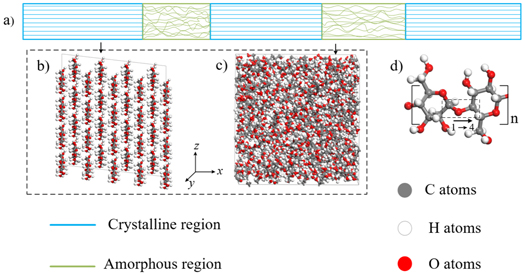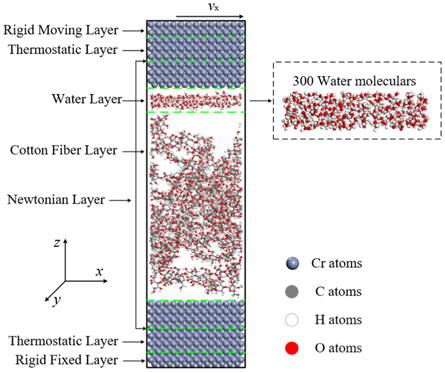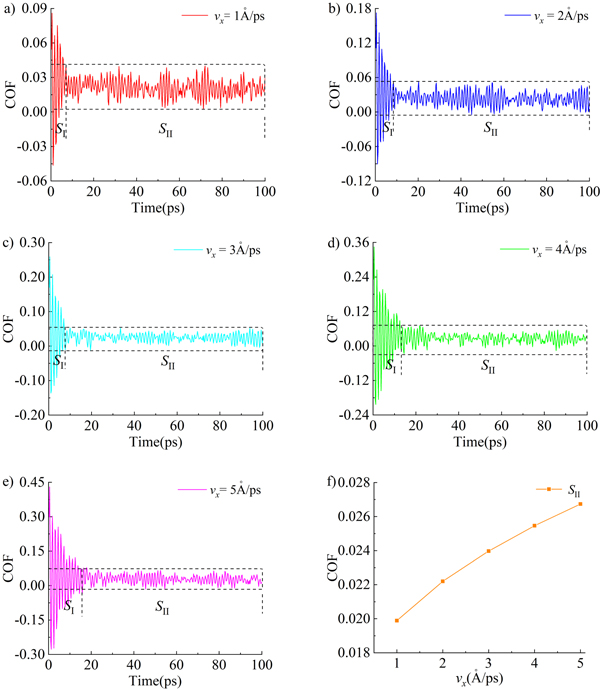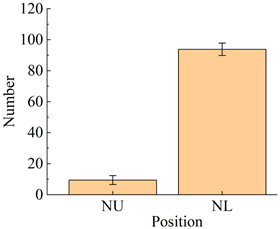Abstract
This study investigates the influence of sliding velocity and loading on the friction of chromium and amorphous cotton fibers using water molecules act as lubricants via molecular dynamics simulation. It is found that the movement of water molecules between the contact interfaces is mainly along the sliding-direction not than the loading-direction during the sliding process. The high sliding velocity or large loading will reduce the lubricating properties of water molecules and increase the average coefficient of friction in the stabilization. The sliding time before the stabilization increase with sliding velocity while decreases with loading. Moreover, the water-lubricants can reduce the damage to chromium, and the increase of sliding velocity is more easy to cause the damage than loading, so it is more important to choose a right sliding velocity.
Export citation and abstract BibTeX RIS

Original content from this work may be used under the terms of the Creative Commons Attribution 4.0 licence. Any further distribution of this work must maintain attribution to the author(s) and the title of the work, journal citation and DOI.
1. Introduction
As a natural fiber composite material, cotton has become the main raw material for textile because of its excellent heat preservation, comfort and high specific strength due to low density [1], and plays an important role in the textile industry and daily life, promoting the development of human civilization. With the growth of the global population, the demand for cotton is increasing and it has become white gold [2]. However, in the process of picking to making textiles, there will be friction with machine parts of different materials, and these frictions will lead to wear and damage to machine parts [3–6]. Improving the wear resistance of surface is an important way to extend the service life of parts, the chromium (Cr) is often used as a surface coating material for metal parts because of its high hardness, heat resistance, wear resistance and strength [7]. Therefore, it is particularly important to study the frictional wear of cotton and Cr.
Natural cellulose is the main component of cotton and determines its chemical and physical properties [8]. The friction of cotton with different materials actually is the cellulose with different materials, and in the past decades, many researches have conducted experiments to investigate the frictional wear of cellulose. Bogdanovic et al [9] studied sliding friction between cellulose and silica using atomic force microscope, which is important for analyzing the relationship between friction and chemical surface properties. Using the same measuring apparatus, Stiernstedt et al [10] investigated the friction between cellulose surfaces and showed that the forces between cellulose are monotonically repulsive with negligible adhesion after contact is achieved. Zauscher et al [11, 12] studied sliding friction between cellulose surfaces using colloidal probe microscopy, contributing to a better understanding of the frictional wear between cellulose surfaces. Farzad, H. et al [13] studied the cellulose friction properties of different cotton using a sliding friction tester and indicated that the friction properties of cotton cellulose varied among varieties.
The results of these experimental studies are reliable and helpful in understanding the friction of cellulose, however, the friction at the micro/nano-scale is still unclear due to the limitations of experimental approaches. The molecular dynamics (MD) simulation has the capability of observing the evolution of microstructures and analyzing frictional wear of various materials (such as metals, polymers, silicon) at the micro/nano-scale [14–25]. PanDeng et al [24] and Hao, X. H et al [25] not only investigated the friction properties of polytetrafluoroethylene (PTFE) by combining experimental and MD simulation, but also confirmed that MD simulation is an effective approach to study the frictional wear at the micro/nano-scale. In addition, many researches have conducted to investigate the properties of cellulose via MD simulation [26–36], which is helpful in further understanding the cellulose characteristics. YanZhe et al [5, 6] studied the dry friction between cellulose and Cr and the results showed that serious damage to Cr due to the friction force and the coefficient of friction (COF) are too large. Both of the friction force and COF needed to be greatly reduced to protect Cr and prolong its service life, an effective way is using the lubricants, such as oil, water, ionic liquids and other aqueous lubricants [37–39].
Using the lubricants is an effective way to reduce friction, but oil and ionic liquids lubricants are expensive and can lead to environmental pollution. Therefore, using water-lubrication is a promising solution and becoming increasingly widespread in the industrial lubrication due to its good environmental compatibility, high thermal conductivity and low cost [40–45]. Currently, the mechanism of water-lubrication has been studied using MD simulations [46–49]. Song Jingfu et al [47] built the molecular models of PTFE sliding against Cu atoms layer under dry friction and water-lubrication and simulated to reveal that the average COF of PTFE in the steady stage decreased from 0.189 to 0.064 after water molecules act as lubrications. Li Chenjie et al [48] investigated water-based lubricants with graphene and found that the friction reduction by water-based lubricants is due to the enhanced isolation between friction pairs by the graphene presence and the improvement of water replenishment. ChenHuan et al [49] investigated the influence of water-lubrication on the friction of diamond-like carbon films and found that water molecules at contact interfaces prevent the formation of interfacial C–C covalent bonds and show hydrodynamic lubrication effects, and thus effectively postpone the friction increase in initial friction stages. The principle of water lubrication has been widely recognized and employed to reduce the friction or improve the wear resistance of materials, but the friction of chromium and cotton fibers using water act as lubricants is still unclear.
In the present work, the friction behavior of Cr and amorphous cotton fibers (ACF) using water molecules act as lubricants were investigated by considering the influence of different sliding velocity and loading via MD simulation. It makes a good contribution to understand how sliding velocity and loading affects the water-lubricated friction between Cr and ACF at the micro/nano-scale and hoped to provide a basis for their lubrication in the future.
2. Modelling and Simulation
2.1. The cellulose model
Cellulose is a linear polysaccharide of β-D- pyran glucose-group linked by 1–4-β- glycosidic bonds, and two glucose units forming a celllobiose which is the repeat unit of cellulose. Cellulose includes crystalline region which is arranged in a highly ordered structure and amorphous region which is disordered [8, 27, 50, 51] as shown in figure 1. The properties of crystalline region and amorphous region are very different and need to be studied separately, in this paper, amorphous cellulose is taken as the object. The amorphous cellulose with degrees of polymerization (DP) of 30 were constructed, and packed 3 chains in the cell with a density of 1.5 g cm−3 [52] in the simulation model as shown in figure 2.
Figure 1. (a) Schematics of the crystalline cellulose and amorphous cellulose. Molecular structure of (b) crystalline cellulose and. (c) amorphous cellulose. (d) The repeat unit of cellulose.
Download figure:
Standard image High-resolution imageFigure 2. The model of Cr-water-ACF in MD simulation.
Download figure:
Standard image High-resolution image2.2. The simulation model
The simulation model has two Cr layers with 300 water molecules and the ACF are placed between them as show in figure 2. The two Cr layers have the same size of 34.6 Å × 34.6 Å × 23.1 Å, and each of layer has 2304 Cr atoms. The model includes three layers, and the outermost layers are rigid layers which consists of Rigid Fixed Layer (RFL) in the bottom and Rigid Moving Layer (RML) in the top along the z-direction. The geometry of Cr atoms in the rigid layers keep unchanged during the simulation. In addition, the RFL is fixed and the RML is used to undertake the loading to the simulation model along the z-direction and the sliding velocity along the x-direction. Adjacent to the rigid layers are the thermostatic layers, where the temperature is kept constant at 300 K by rescaling their atom velocity. Except for the rigid layers and the thermostatic layers, the rest of atoms are defined as Newtonian layer consists of Cr atoms, water molecules and the ACF. The atoms in the Newtonian layer can move freely on the basis of Newton's second law of motion. Before the MD simulation starts, five anneal processes were performed under constant temperature and constant volume (NVT ensemble) from 300 K to 500 K with a rate of 4 K ps−1 and decreases to 300 K with a high rate of 80 K ps−1 to further equilibrate the simulation model.
The friction simulation consists of three stages. In the first stage, the relaxation at a constant temperature of 300 K is followed to eliminate the internal stress in the model and promote the movement of water molecules to distribute them randomly. In the second stage, applies the loading (Fn) to the RML along the z-direction by adding a uniform force to the Cr atoms. In the last, a sliding velocity (vx) along the x-direction is applied to the RML to achieve a relative sliding between Cr layer and ACF. Boundary conditions are all periodic in the x and y-directions to solve the problem of the boundary effect of ACF on the Cr substrate, while aperiodic boundary is taken in the z-direction. The timestep of simulation is 0.25 fs, and the simulation time of three stages are 100 ps, 200 ps and 100 ps to ensure them becoming stable. The two considered factors that vx is set as 1 Å/ps, 2 Å/ps, 3 Å/ps, 4 Å ps−1 and 5 Å ps−1 when the Fn is 5 GPa and Fn is set as 1 GPa, 3 GPa and 5 GPa when the vx is 1 Å/ps. Hence, there are 7 simulations were performed in the study.
All the simulations were done by the large-scale atomic/molecular massively parallel simulator (LAMMPS) which is an open-source coding for MD simulation [53]. The interactions among atoms are evaluated by the reactive force field (ReaxFF) developed by Shin et al [54] which is agreement with YanZhe et al [5, 6] investigated the dry friction between Cr and cotton fiber. The ReaxFF allows for bonds to break and form during the simulation and the connectivity is determined by bond orders calculated from interatomic distances. The overall system energy Esystem in ReaxFF consists of various partial energy terms as shown in equation (1):

where Ebond is the covalent interaction energy, Eunder and Eover are atom under/overcoordination, Eval is the bond angle interaction energy, Epen is the compensation energy, Etors is the dihedral torsion energy, Econj is the bond binding energy, and EvdWaals is the van der Waals action energy, ECoulomb is electrostatic action energy.
3. Results and discussions
3.1. The movement of water molecules in different conditions
The movement of water molecules between contact interfaces significantly affects the friction behavior of Cr and ACF due to they act as lubricants. The mean-squared displacement (MSD) is a significant parameter to reflect the movement of liquid which was used to study the movement of water molecules during sliding to clarify its influence on the friction mechanisms [48, 49]. The MSD of water molecules in different conditions as shown in figure 3. It is seen from figure 3(a) that the movement of water molecules along the x-direction (the sliding direction) (MSDx ) changes significant to a high value while almost unchanged in a low value along the y-direction (MSDy ) and the z-direction (the loading direction) (MSDz ) during the friction process in the condition of Fn is 5 GPa and vx is 1 Å/ps. This indicates that the total movement of water molecules (MSDw ) is dominated by the movement along the sliding direction (MSDx ) not than the loading direction (MSDz ) or the other direction (MSDy ). The MSDw in other conditions (different Fn and vx) are not shown because of they have the same result.
Figure 3. (a) The MSD of water molecules at Fn = 5 GPa and vx = 1 Å ps−1, the MSDw of water molecules in (b) different vx and (c) different Fn.
Download figure:
Standard image High-resolution imageThe vx and Fn can influence the movement of water molecules as shown in figure 3(b) and figure 3(c) which shows that the MSDw decreases with the increase of vx and Fn. During the sliding process, the water molecules located between the contact interfaces and distributed uniformly due to the adjust movement such as translate and rotate of them with the sliding of Cr. However, the adjust movement of water molecules is slowly relative to the vx and fail to adjust sufficiently at a large vx, then affects the distribution of water molecules on the contact surface. Hence, the large sliding velocity inhibits the movement of water molecules and decreases their lubrication behavior. The viscosity of liquids confined between two objects increases as the pressure increases, so that the viscosity of water molecules located between the contact interfaces increased at a large Fn and affected their movement and distribution. Therefore, a large loading increases the viscosity of water molecules and decreases their lubrication behavior. For these reasons, a large sliding velocity and a large loading affect the activities of water molecules induce to the decrease of MSDw .
3.2. The coefficient of friction in different conditions
The different vx and Fn affect the COF of contact interfaces as shown in figures 4 and 5. In all the conditions, the COF and its fluctuation magnitude are quite high at the beginning of sliding (stage I:SI) due to the fact that the water molecules located between contact interfaces stay static and need some time to flow to act as lubricants. That means the SI is a non-stable lubricated friction state and the COF is large and changes significantly. The water molecules start to act as lubricants which reduce the friction of contact interfaces since their movement tends to stabilize with the sliding going on, and then enters a stable lubricated friction state (stage II:SII). The COF changes smoothly and its fluctuation magnitude within a small range during the SII process and using its average value to compare the effect of water lubrication in the condition.
Figure 4. (a)–(e) The COF at Fn is 5 GPa and vx is 1 ∼ 5 Å ps−1, (f) influence of vx on the average COF in the stabilization.
Download figure:
Standard image High-resolution imageIn the condition of Fn is 5 GPa, the vx (1 ∼ 5 Å ps−1) affects the COF as shown in figures 4(a)–(e). The sliding time of SI increases with vx since the large vx inhibits the movement of water molecules and requires more time to complete lubrication. It can be seen from figure 4(f) that the average COF also increase with vx in the SII process, it is because that the lubrication of water molecules decreases with vx resulted from the large vx inhibits their movement. However, the change in the average COF becomes progressively smaller with the increase of vx due to the fact that its ability to inhibit the movement of water molecules decreases, which is consistent with the trend of MSDw shown in figure 3(b). Under given vx (1 Å ps−1), the different Fn affects the COF shown in figures 5(a)–(c). As shown in figure 3(c), the water molecules are more easy to get the stabilization because of their movement activity decrease at a large Fn which is caused by their viscosity increase, so the sliding time of SI decreases with Fn. In addition, the lubrication of water molecules decrease affected by their viscosity induce to the increase of average COF while decrease of its fluctuation magnitude as shown in figure 5(d).
Figure 5. (a)–(c) The COF at vx is 1 Å/ps and Fn is (1,3,5) GPa, (d) influence of Fn on the average COF in the stabilization.
Download figure:
Standard image High-resolution image3.3. The damage to Cr in different conditions
After a period of friction between Cr and ACF, the chemical changes take place at the contact surfaces which is generated by oxygen atoms in the ACF and Cr atoms produce Cr=O bonds to produce Cr2O3 and induce to the damage to Cr [5]. The Cr=O bonds are manifestations of damage on the surface of Cr substrates, so the number of Cr=O bonds was calculated to analyze the damage to Cr during friction process. The formation and breaking of Cr=O bonds are evaluated according a cutoff length of 1.96 Å, and the number of Cr=O bonds generated by oxygen atoms in the ACF with Cr atoms in the upper layer is NU and the number generated with lower layer is NL. The NU and NL in the condition of vx is 1 Å/ps and Fn is 5 GPa are used to compare the damage to Cr by friction with and without water molecules as shown in figure 6. It is noted that NU is much smaller than NL since water molecules act as lubricants protect Cr and decrease its damage. During the friction with lubrication of water molecules, the ACF and Cr are not contact directly because of the lubricants separated them and formed a lubricating film between them. In the situation, the sliding between contact interfaces is mainly depends on the flowing of the lubricants. In the influence of water molecules act as lubricants, both the friction force between Cr and ACF and the damage to Cr are decreased which resulted in the NU is very small relative to NL. And it is contrary to what happens during friction without lubricant. To show the variation of NU and NL clearly, using their average value as shown in figure 6.
Figure 6. The NL and NU at vx is 1 Å/ps and Fn is 5 GPa.
Download figure:
Standard image High-resolution imageThe NU is used to analyze the damage to Cr at different vx and Fn during water-lubricated friction as shown in figure 7. It is noted that the NU increases with vx and Fn, and moreover, the effect of vx is greater than Fn due to the fact that the movement of water molecules located between contact interfaces is more dependent on sliding than loading as shown in figure 3(a). In addition, the COF increased with vx and Fn since the movement of water molecules is inhibited, and then causing more damage to Cr. But in the case of lubrication, the ACF and Cr are not contact directly with each other under the action of loading, avoiding the serious damage to Cr caused by the large friction force. Hence, the water molecules act as lubricants is an important way to protect Cr.
Figure 7. The NU at (a) Fn is 5 GPa and vx is 1 ∼ 5 Å ps−1, and (b) vx is 1 Å/ps and Fn is (1,3,5) GPa.
Download figure:
Standard image High-resolution image4. Conclusions
The ACF and Cr contact directly and violent friction occurs on the contact interfaces during the dry friction, while using water molecules act as lubricants to separate them can significantly reduce the friction. This study uses the MD simulation to investigate the performance of the water-lubricated friction between ACF and Cr by analyzing the movement of water molecules, the COF and the damage to Cr at different sliding velocity and loading. It is found that the movement of water molecules between the contact interfaces is mainly along the sliding- direction not than the load-direction, and the movement will be inhibited with the increase of sliding velocity. At the same time, the large loading increases the viscosity of water. Both of the inhibited-movement and increased-viscosity reduce the lubricating property of water molecules and affect the lubricated friction. At the beginning of friction, the water molecules keep static and do not act as lubricants, which will lead to a large COF and fluctuation magnitude. The friction gradually stabilizes as the flowing of water molecules, and the sliding time before the stabilization increases with sliding velocity while decrease with loading. During the stabilization stage, the COF is small and changes in a certain range, and the average COF increases with sliding velocity and loading. The number of Cr=O bonds generated during dry friction NL is much larger than the number generated during water-lubricated friction NU, indicating that water molecules act as lubricants protect Cr from damage. Finally, the ability of sliding velocity to damage the Cr is stronger than loading during water-lubricated friction according to the work. Therefore, using the water-lubrication can protect Cr well and choosing a right sliding velocity is more important.
Data availability statement
All data that support the findings of this study are included within the article (and any supplementary files).
Funding
This work was Supported by 'Bintuan Science and Technology Program (2021CB036)'and 'Innovation Research Team Program of Tarim University President Funded (TDZKCX202202)'.








